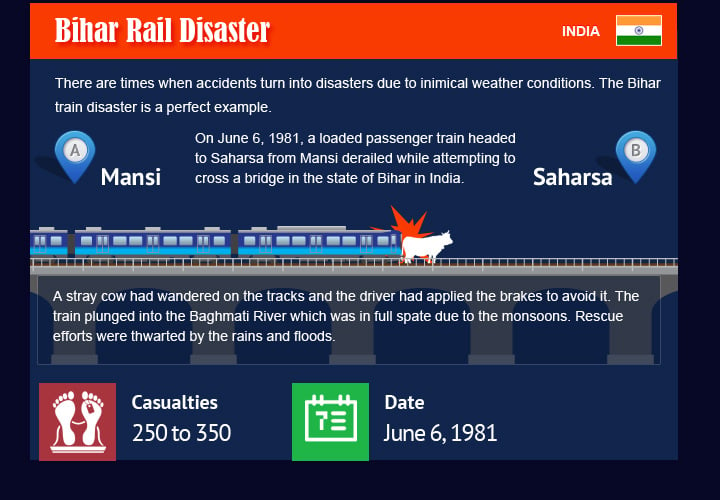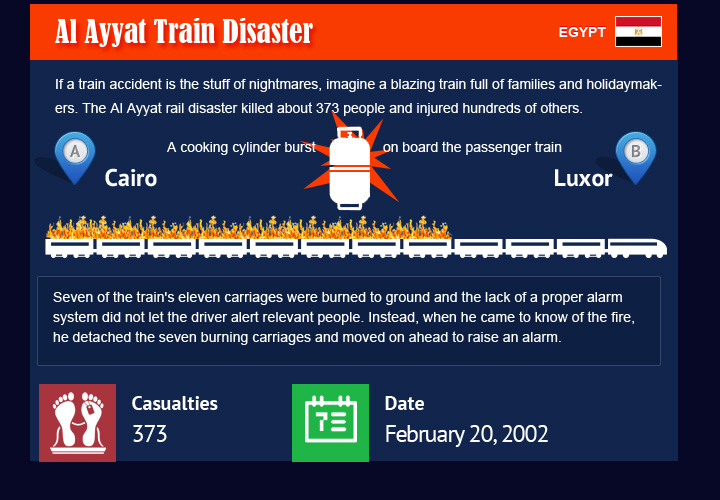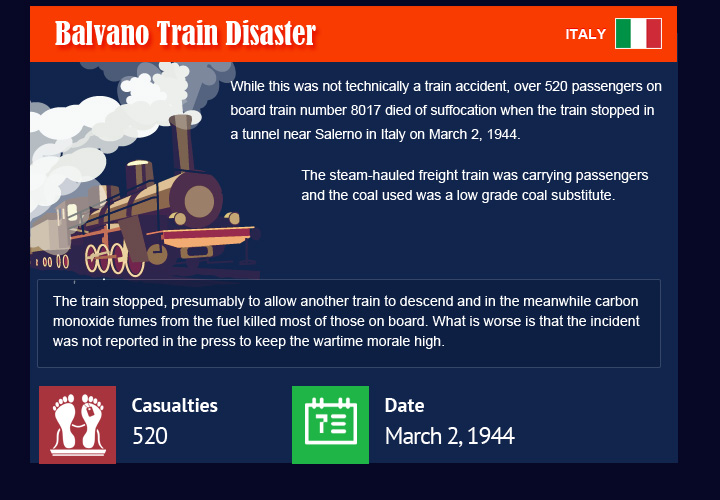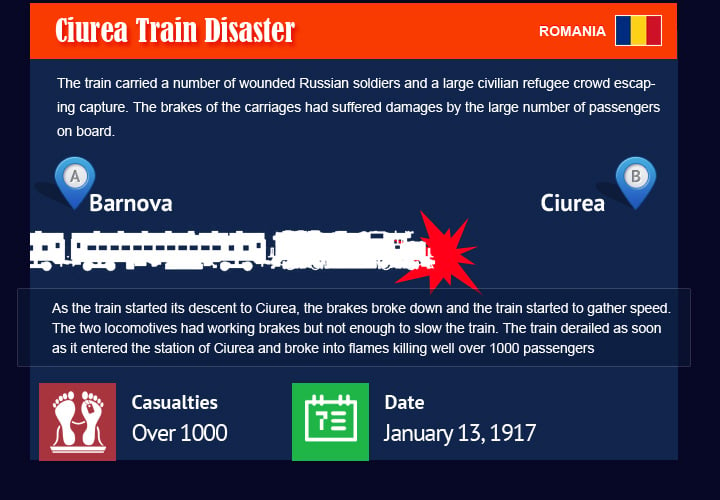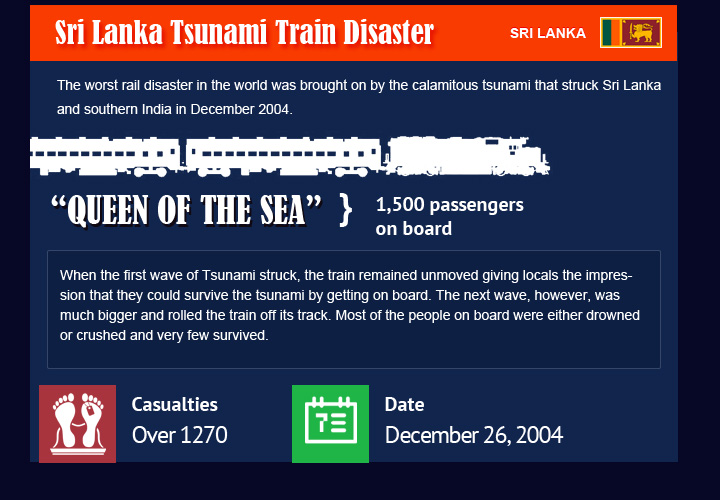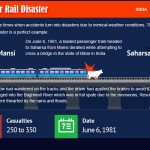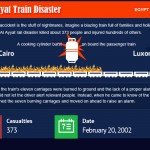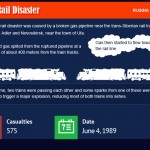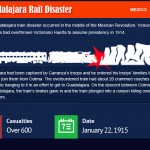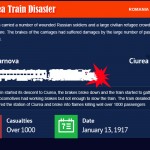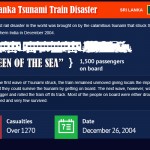Bihar Rail Disaster
Date – June 6, 1981
Country – India
Casualties – 250 to 350
There are times when accidents turn into disasters due to inimical weather conditions. The Bihar train disaster is a perfect example. On June 6, 1981, a loaded passenger train headed to Saharsa from Mansi derailed while attempting to cross a bridge in the state of Bihar in India. A stray cow had wandered on the tracks and the driver had applied the brakes to avoid it. The train plunged into the Baghmati River which was in full spate due to the monsoons. Rescue efforts were thwarted by the rains and floods. 250 corpses were found in the river but about a 100 more were missing.
Al Ayyat Train Disaster
Date – February 20, 2002
Country – Egypt
Casualties – 373
If a train accident is the stuff of nightmares, imagine a blazing train full of families and holidaymakers. The Al Ayyat rail disaster killed about 373 people and injured hundreds of others. A cooking cylinder burst on board the passenger train between Cairo and Luxor. Seven of the train’s eleven carriages were burned to the ground and the lack of a proper alarm system did not let the driver alert relevant people. Instead, when he came to know of the fire, he detached the seven burning carriages and moved on ahead to raise an alarm. Third class trains at the time used to be filled to the brink and had no proper reservation charts making it difficult to identify most of the people on board.
Awash Rail Disaster
Date – January 14, 1985
Country – Ethiopia
Casualties – 378 to 450
The train that plunged into a ravine near Awash in Ethiopia was a small one with merely five carriages. Despite this, the disaster is considered to be one of the worst in the rail history of Africa. About 392 people were reported dead and another 370 were injured by the crash. The train had set off from Djibouti and was on its way to Addis Ababa. It had gone past Diredawa when the accident occurred. It is believed that the train’s engineer failed to control its speed as it approached a curve and the train plunged into a riverbed about 35 feet below. Though official reports say 378 deaths occurred, rescuers peg the figure at about 450.
Torre del Bierzo Rail Disaster
Date – January 3, 1944
Country – Spain
Casualties – 500
In what is deemed the worst rail disaster to have occurred in Spain, three trains collided inside the tunnel near Torre del Bierzo in Spain on January 3, 1944. The Galicia Mail Express train lost its brakes and despite all efforts to slow it down was tearing towards Tunnel 20 past the Torre del Beirzo station. A shunting engine and some carriages were stuck in the tunnel, unable to get out of the way in time. The collision caused a fire to break out. This caused a breakdown in the signal mechanism and a coal train headed to Tunnel 20 also collided with the two trains. The coal caused a massive fire and about 500 people died in the accident. Strict censorship due to the Spanish Civil War resulted in 78 deaths being reported at the time.
Balvano Train Disaster
Date – March 2, 1944
Country – Italy
Casualties – 520
While this was not technically a train accident, over 520 passengers on board train number 8017 died of suffocation when the train stopped in a tunnel near Salerno in Italy on March 2, 1944. The steam-hauled freight train was not supposed to carry passengers but like most war time trains it did and the coal used was a low grade coal substitute. After passing through Eboli, Persano, and Romagnano, the train stopped at Balvano and then started a sharp ascent trough the Galleria delle Amri tunnel. The train stopped, presumably to allow another train to descend and in the meanwhile carbon monoxide fumes from the fuel killed most of those on board. What is worse is that the incident was not reported in the press to keep the wartime morale high.
Ufa Rail Disaster
Date – June 4, 1989
Country – Russia
Casualties – 575
The Ufa rail disaster was caused by a broken gas pipeline near the trans-Siberian rail track between Adler and Novosibirsk, near the town of Ufa. Liquefied gas spilled from the ruptured pipeline at a distance of about 400 meters from the train tracks. Gas then started to flow towards the rail line. At this time, two trains were passing each other and some sparks from one of these were enough to trigger a major explosion, reducing most of both trains into ashes. Rescue work was slow and 575 people were officially reported dead. Unofficial sources say that the death toll may have been higher.
Guadalajara Rail Disaster
Date – January 22, 1915
Country – Mexico
Casualties – Over 600
The early 1900s were particularly known for their deadly train disasters for two reasons. Firstly, these were the early days of rail technology and safety mechanisms, if any, were frugal and locomotives scarce. Secondly, these were the days of war and bloody strife in many parts of the world and overcrowding of trains was a natural catalyst for disaster. The Guadalajara train disaster occurred in the middle of the Mexican Revolution. Venustiano Carranza had overthrown Victoriano Huerta to assume presidency in 1914. Early the following year, Guadalajara had been captured by Carranza’s troops and he ordered his troops’ families to be moved to join them from Colima. The overburdened train had about 20 crammed coaches and had people hanging to it in an effort to get to Guadalajara. Predictably, on the descent between Colima and Guadalajara, the train’s brakes gave in and the train plunged into a canyon killing over 600 passengers.
Saint Michel de Maurienne Rail Accident
Date – December 12, 1917
Country – France
Casualties – Over 700
The deadliest train accident in the history of France comes from World War I times. About 982 French soldiers were returning home for Christmas on leave. Due to an acute shortage of engines at the time, the commanding officer of the railways ordered to couple together two trains to be pulled by a single engine. Most of the coaches had no brakes and the driver was coerced into driving the train despite major safety concerns. As the train started to descend into a valley in the French Alps, the brakes failed and it tore through the tracks before derailing and catching fire. It is estimated that over 700 soldiers died in the accident; only about 450 of them could be recognized.
Ciurea Train Disaster
Date – January 13, 1917
Country – Romania
Casualties – Over 1000
In another major wartime rail disaster, an overburdened train of about 26 carriages started off from Barnova toward Ciurea on January 13, 1917. The train carried a number of wounded Russian soldiers and a large civilian refugee crowd escaping capture. The brakes of the carriages had suffered damage by the large number of passengers on board. As the train started its descent to Ciurea, the brakes broke down and the train started to gather speed. The two locomotives had working brakes but not enough to slow the train. The train derailed as soon as it entered the station of Ciurea and broke into flames killing well over 1000 passengers.
Sri Lanka Tsunami Train Disaster
Date – December 26, 2004
Country – Sri Lanka
Casualties – Over 1270
The worst rail disaster in the world was brought on by the calamitous tsunami that struck Sri Lanka and southern India in December 2004. In all, the tsunami killed 28,000 people from various countries including most of the 1,500 passengers on board the “Queen of the Sea” – a popular passenger train of the Sri Lankan coastal railways. The train, a popular choice for passengers between Colombo and Galle, reached Peraliya (Hikkaduwa) at about 9.30 am when the first wave of Tsunami struck. The train remained unmoved giving locals the impression that they could survive the tsunami by getting on board. The next wave, however, was much bigger and rolled the train off its track. Most of the people on board were either drowned or crushed and very few survived.



